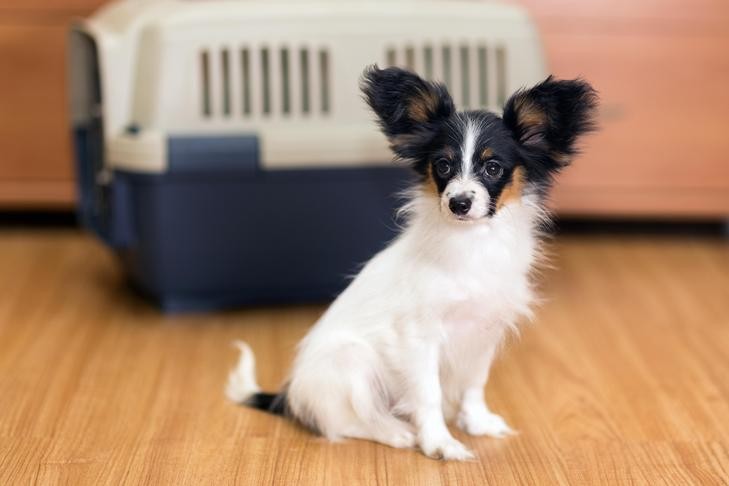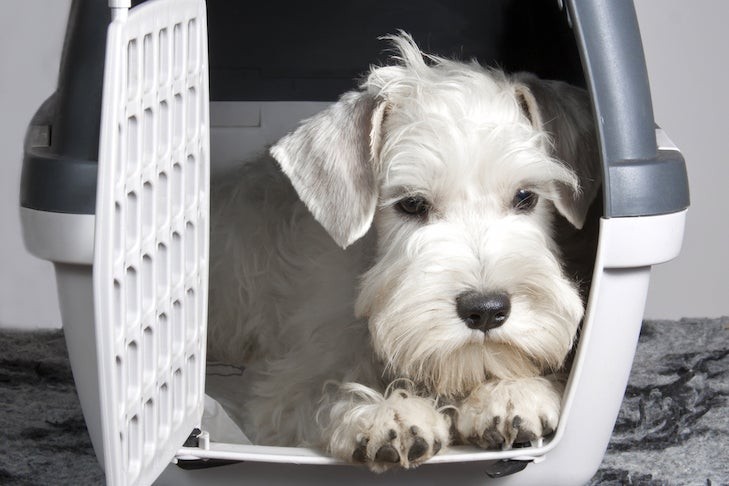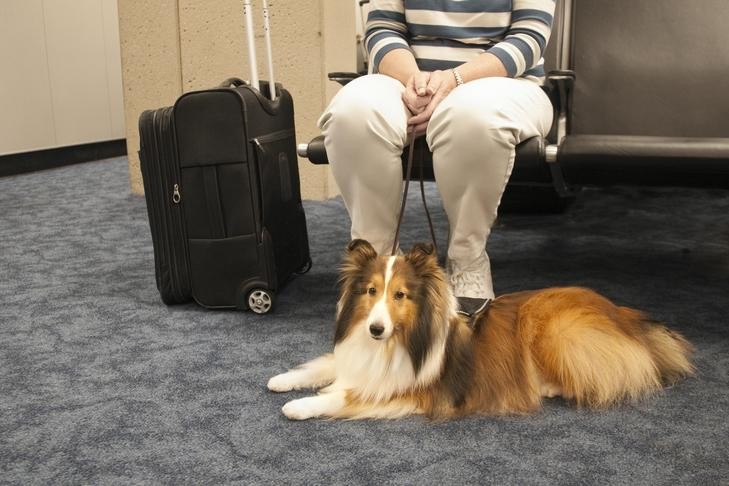Can Dogs Travel On Planes? Absolutely, many airlines accommodate canine companions, but careful planning is essential for a smooth and stress-free journey for both you and your furry friend. SIXT.VN is here to help you navigate the complexities of pet travel in Vietnam, ensuring a seamless experience with our comprehensive travel solutions. Let’s explore everything you need to know about air travel with dogs, including airline policies, health requirements, and tips for a comfortable flight, complete with reliable airport transfer services upon your arrival.
1. Determining If Flying Is Right for Your Dog
Before booking that flight, it’s crucial to assess whether air travel is suitable for your dog. Is flying good for dogs?
Answer: Traveling by air can indeed be stressful for dogs due to unfamiliar sounds, sights, and smells. According to Dr. Jerry Klein, Chief Veterinary Officer of the American Kennel Club, these factors can be challenging for pets. Consider your dog’s temperament and health before making a decision.
1.1 Health Considerations
Changes in diet and water during travel can upset your dog’s stomach. Time zone changes and the disruption of routines may lead to dehydration or interfere with medication schedules. Consult your veterinarian to determine if your dog is fit for air travel.
1.2 Stress Factors
The American Veterinary Medical Association (AVMA) notes that air travel can expose animals to temperature extremes, loud noises, and stressful handling. These factors can be particularly risky for dogs with underlying health conditions.
 Papillon sitting indoors with a traveling crate in the background.
Papillon sitting indoors with a traveling crate in the background.
2. Essential Preparations for Flying with Your Dog
Proper preparation is key to a successful trip. What do I need to know?
Answer: Research airline policies, check destination restrictions, and ensure your dog meets all health and documentation requirements. The AKC provides state-by-state travel requirements, but international travel may have additional rules.
2.1 Airline Policies
Contact the airline well in advance to understand their specific pet policies, including carrier size restrictions, breed restrictions, and any necessary documentation. Most airlines allow small dogs to fly in the cabin if they are in a carrier that fits under the seat.
2.2 Booking Flights
Opt for direct flights whenever possible to minimize stress and potential delays. When booking, consider the time of year. Choose early morning or evening flights in the summer to avoid high temperatures, and midday flights in the winter to avoid the cold.
2.3 International Travel Requirements
The Centers for Disease Control and Prevention (CDC) has specific guidelines for dogs entering the U.S. As of August 2024, owners must submit a CDC-approved Dog Import Form online in advance. All dogs must be immunized against rabies, be at least 6 months old, and have an International Standards Organization standard microchip.
For dogs from high-risk countries, a U.S. rabies vaccine certificate, a certification of foreign-issued rabies vaccination, or a certification of foreign rabies vaccination, along with a microchip form, is required. In some cases, quarantine may be necessary upon arrival.
3. Health Checklist for Your Dog Before Flying
Ensuring your dog’s health is paramount before any flight. What should I check?
Answer: Schedule a vet appointment, prepare medications, and ensure you have an ample supply of any specialized diets your dog requires. A healthy dog is better equipped to handle the stresses of travel.
3.1 Veterinary Examination
Even if a health certificate isn’t required, a vet visit is essential. Your vet can confirm your dog is healthy enough to travel and that all vaccinations are up-to-date. Obtain an updated rabies certificate.
3.2 Medication Preparation
Pack enough of any prescription medications for the entire trip, plus extra in case of delays. Don’t forget preventative flea and tick medications.
3.3 Special Diets
If your dog requires a specialized or prescription diet, bring an ample supply. You may not be able to find it while traveling.
4. Essential Items to Pack When Flying with Your Dog
Packing the right items ensures your dog’s comfort and safety. What should I pack?
Answer: Bring proof of vaccinations, an airline-approved carrier, portable bowls for food and water, treats, poop bags, pet wipes, and a chew toy. These items will help manage your dog’s needs during the trip.
4.1 Required Documents
Check if a health certificate is needed for your destination. Even if not required, having these documents can be useful. Be sure to check entry requirements, including quarantine information.
4.2 Airline-Approved Carrier
Ensure your carrier meets the airline’s size requirements. The carrier should be waterproof and provide enough room for your dog to sit, stand, lie down, and turn around.
4.3 Comfort Items
Pack a portable water bowl, a food bowl, a small amount of food, treats, poop bags, and pet wipes. A chew toy can help relieve pressure during takeoff and landing.
 Sealyham Terrier laying down in a travel crate.
Sealyham Terrier laying down in a travel crate.
5. Preparing Your Dog for the Experience of Flying
Familiarizing your dog with the travel process can reduce anxiety. How do I prepare my dog?
Answer: Acclimate your dog to their crate early, expose them to crowded and noisy environments, and ensure they are well-behaved. Training can also be beneficial.
5.1 Crate Familiarization
Allow your dog to explore their crate at home. Pair going into the crate with praise and treats to create a positive association.
5.2 Exposure to Public Spaces
Bring your dog to dog-friendly places, like bus stations and pet stores, to help them get used to the sights and sounds of an airport.
5.3 Behavioral Training
Airlines require dogs to be well-behaved, meaning they shouldn’t bark excessively, growl, or act aggressively. Consider earning your dog’s Canine Good Citizen (CGC) title. The skills learned, such as walking through a crowd and behaving politely around other dogs, will help prepare your dog for being in an airport.
Some trainers simulate an airplane environment to teach dogs how to sit under a seat in a carrier.
6. Navigating the Airport with Your Dog
Knowing what to expect at the airport can ease stress. What is the process?
Answer: If your dog is flying via cargo, you’ll check them in with the airline. If they’re traveling in the cabin, you’ll need to go through TSA security. Most airports have pet relief areas.
6.1 Check-In Procedures
For cargo travel, airline staff will handle your dog’s crate from check-in to destination. For cabin travel, proceed through TSA screening.
6.2 Security Screening
Your dog will need to come out of their carrier for security. You’ll go through the full-body scanner, and TSA personnel will screen the carrier, collar, harness, and leash.
6.3 Pet Relief Areas
Take advantage of pet relief areas to allow your dog to relieve themselves before the flight.
7. Managing Your Dog During the Flight
Keeping your dog comfortable during the flight is essential. How can I help?
Answer: Your dog must stay in their carrier during the flight. Offer a chew toy to comfort them during turbulent or noisy periods.
7.1 In-Cabin Requirements
Dogs aren’t allowed to sit on their owner’s lap and must remain in their carrier at all times.
7.2 Comfort Techniques
Give your dog a chew toy to help them relax and adjust to pressure changes during takeoff and landing.
8. Airline-Specific Guidelines for Traveling with Dogs
Each airline has its own policies for pet travel. What are the specifics?
Answer: Contact your airline before purchasing tickets to confirm space for your dog and to understand all guidelines. The following provides a general overview of the most common airlines.
8.1 Alaska Airlines
- Health and Vaccine Requirements: Health certificates or proof of vaccination are not required for dogs in the cabin but are needed for cargo travel.
- Dogs in the Cabin: Yes, small dogs are allowed in approved carriers. Two dogs of similar size may travel in the same carrier if comfortable.
- Restrictions: First-class cabins can accommodate three pet carriers per flight, while the main cabin can accommodate eight.
- Dogs in Cargo: Yes, dogs must be at least 8 weeks old and weaned.
- Cargo Restrictions: The combined weight of the dog and crate cannot exceed 150 pounds.
- Fee: $100 per pet for cabin or cargo travel.
8.2 American Airlines
- Health and Vaccine Requirements: Health certificates are required for cargo travel within 20 days of the flight.
- Dogs in the Cabin: Yes, in approved carriers under the seat for flights up to 11 hours and 30 minutes.
- Restrictions: A maximum of five to seven pets are allowed in the cabin per flight, depending on the plane.
- Dogs in Cargo: Only permitted for active-duty US Military and US State Department Foreign Service personnel.
- Fee: $150 per carrier for cabin travel; cargo fees vary.
8.3 Delta
- Health and Vaccine Requirements: Health certificates are required for cargo travel within 10 days of the trip.
- Dogs in the Cabin: Yes, in carriers that fit under the seat with ventilation openings.
- Restrictions: Dogs must be at least 8 weeks old for domestic flights and 16 weeks for international flights to the U.S.
- Dogs in Cargo: Yes, carriers must comply with International Air Transport Association (IATA) regulations.
- Fee: $95 each way for domestic flights; $200 for international flights.
8.4 Frontier
- Health and Vaccine Requirements: No health certificate requirements, but destinations may require them.
- Dogs in the Cabin: Yes, dogs at least 8 weeks old are allowed on domestic flights and flights to/from the Dominican Republic and Mexico.
- Restrictions: Dogs must be able to stand, turn around, and lie down in a natural position in a soft-sided carrier.
- Dogs in Cargo: No.
- Fee: $99 each way.
8.5 Hawaiian Airlines
- Health and Vaccine Requirements: Health certificates are required for flights between Hawaii and the U.S. Mainland within 14 days of arrival. Contact the Hawaii Department of Agriculture for quarantine and vaccine requirements.
- Dogs in the Cabin: Yes, on certain flights.
- Restrictions: Permitted on interisland flights within Hawaii and flights between the mainland U.S. and Hawaii. The combined weight of the pet and carrier cannot exceed 25 pounds.
- Dogs in Cargo: Yes, but the weight of the pet and carrier must not exceed 70 pounds.
- Cargo Restrictions: No cargo travel between April 15 and October 15 or when temperatures are below 20F or above 85F. No international cargo flights.
- Fee: $35 for flights within Hawaii and $125 for flights between Hawaii and the mainland U.S.
8.6 JetBlue
- Health and Vaccine Requirements: Dogs must have required vaccines and documentation for the destination.
- Dogs in the Cabin: Yes, dogs under 20 pounds can fly in carriers in the cabin.
- Restrictions: The combined weight of the dog and carrier must be no more than 20 pounds.
- Dogs in Cargo: No.
- Fee: $125 for each flight.
8.7 Southwest Airlines
- Health and Vaccine Requirements: Passengers must comply with destination requirements for vaccinations and health certificates.
- Dogs in the Cabin: Yes, for domestic flights only.
- Restrictions: In-cabin pets are accepted on a first-come, first-serve basis until the plane capacity of six pets is reached.
- Dogs in Cargo: No.
- Fee: $125 per pet carrier for U.S. Mainland flights and $35 per pet carrier between Hawaiian Islands.
8.8 Spirit
- Health and Vaccine Requirements: Health certificates are not required, except for flights to the US Virgin Islands. Proof of rabies vaccination is required for dogs traveling to Puerto Rico.
- Dogs in the Cabin: Yes, dogs at least 8 weeks old are permitted on domestic flights.
- Restrictions: A passenger can bring one pet carrier with up to two dogs inside, provided the combined weight does not exceed 40 pounds.
- Dogs in Cargo: No.
- Fee: $125 per flight.
8.9 United
- Health and Vaccine Requirements: Health certificates are encouraged but not required for domestic flights. Proof of rabies vaccinations and health certificates are required for international flights.
- Dogs in the Cabin: Yes, dogs at least 2 months old are permitted on domestic flights and 4 months old for international flights.
- Restrictions: The number of pets allowed in the cabin depends on the aircraft.
- Dogs in Cargo: No.
- Fee: $125 per flight with dogs. An additional $125 fee applies for layovers longer than four hours for domestic flights or 24 hours for international flights.
 Shetland Sheepdog service dog laying next to its owner at the airport.
Shetland Sheepdog service dog laying next to its owner at the airport.
9. Post-Flight Care for Your Dog
After the flight, give your dog time to adjust. What should I do?
Answer: Provide a calm environment, ensure access to fresh water and food, and monitor for any signs of stress or illness.
9.1 Re-Establish Routine
Get back to your dog’s regular feeding and exercise schedule as soon as possible.
9.2 Monitor Health
Watch for signs of stress, such as diarrhea, vomiting, or changes in behavior. Contact your vet if you have any concerns.
10. How SIXT.VN Can Assist You With Your Travel Plans
Traveling to Vietnam with your dog? SIXT.VN offers a range of services to make your trip seamless and stress-free. How can SIXT.VN help?
Answer: SIXT.VN provides airport transfer services, hotel booking assistance, and personalized travel itineraries, ensuring a smooth and convenient experience for you and your pet.
10.1 Airport Transfers
SIXT.VN offers reliable and comfortable airport transfer services, ensuring you and your dog arrive at your destination safely and on time. Our professional drivers are experienced and courteous, providing a hassle-free transfer experience.
10.2 Hotel Booking Assistance
Finding pet-friendly accommodations can be challenging. SIXT.VN can assist you in booking hotels that welcome pets, ensuring a comfortable stay for you and your furry friend. We work with a wide range of hotels to meet your specific needs and preferences.
10.3 Personalized Travel Itineraries
SIXT.VN can create personalized travel itineraries tailored to your interests and needs, including pet-friendly activities and destinations. Whether you want to explore the bustling streets of Hanoi or relax on the beaches of Phu Quoc, we can design the perfect itinerary for you and your dog.
10.4 Comprehensive Travel Solutions
From visa assistance to local transportation, SIXT.VN provides comprehensive travel solutions to ensure a smooth and enjoyable trip to Vietnam. Our experienced team is available to assist you with all aspects of your travel planning, making your journey as stress-free as possible.
10.5 Local Expertise
SIXT.VN’s local expertise allows us to provide insider tips and recommendations for traveling with your dog in Vietnam. We can advise on the best pet-friendly restaurants, parks, and attractions, ensuring you and your dog have a memorable experience.
Traveling with your dog on a plane requires careful planning and preparation. By following these guidelines and utilizing the services offered by SIXT.VN, you can ensure a safe, comfortable, and enjoyable trip for both you and your beloved pet. Contact SIXT.VN today to start planning your next adventure to Vietnam.
Address: 260 Cau Giay, Hanoi, Vietnam
Hotline/Whatsapp: +84 986 244 358
Website: SIXT.VN
Frequently Asked Questions (FAQ) About Traveling with Dogs on Planes
1. What size carrier do I need for my dog to fly in the cabin?
Answer: The carrier must fit under the seat in front of you and allow your dog to stand, turn around, and lie down comfortably. Check with your airline for specific size restrictions.
2. Do I need a health certificate for my dog to fly domestically?
Answer: While not always required, it’s best to have your dog examined by a vet and obtain a health certificate. Some destinations may require it.
3. Can I give my dog a sedative before flying?
Answer: Consult your veterinarian before giving your dog any sedatives. Some sedatives can have adverse effects during air travel.
4. How early should I arrive at the airport when flying with my dog?
Answer: Arrive at least 2-3 hours before your flight to allow ample time for check-in and security procedures.
5. Are there breed restrictions for dogs flying on planes?
Answer: Yes, some airlines have breed restrictions, particularly for snub-nosed breeds, due to potential breathing problems. Check with your airline for their specific policies.
6. Can my dog sit on my lap during the flight?
Answer: No, dogs must remain in their carrier under the seat in front of you throughout the flight.
7. What if my dog gets sick during the flight?
Answer: Pack pet wipes and consult with the flight crew for assistance. Clean up any messes promptly to maintain a clean environment.
8. Are emotional support animals still allowed to fly in the cabin for free?
Answer: As of 2021, emotional support animals are considered pets and are subject to the same rules and fees as other pets. Only trained service dogs are allowed to fly openly in the cabin.
9. What should I do if my connecting flight is delayed?
Answer: Contact the airline to ensure your dog’s needs are met during the delay, including access to water and relief areas.
10. Can I book a separate seat for my dog?
Answer: No, it’s not possible to purchase a separate airline seat for your dog. They must travel in a carrier either in the cabin or in cargo, depending on their size and the airline’s policies.



